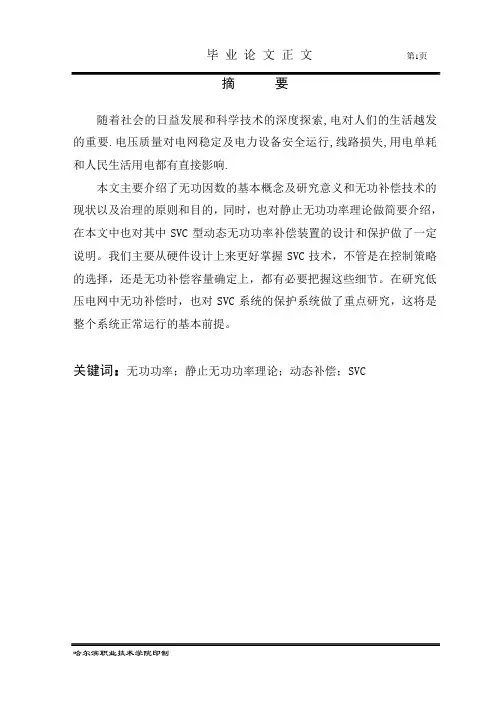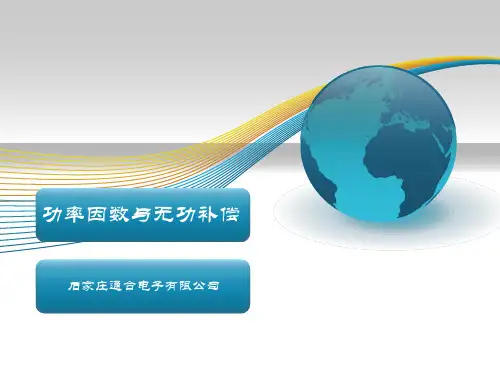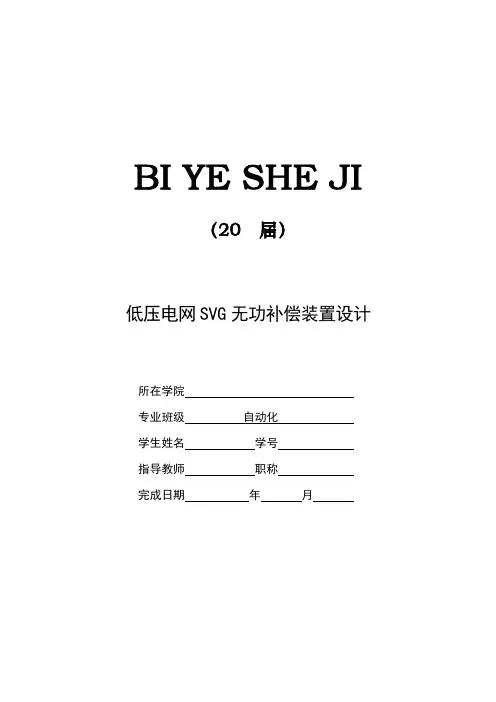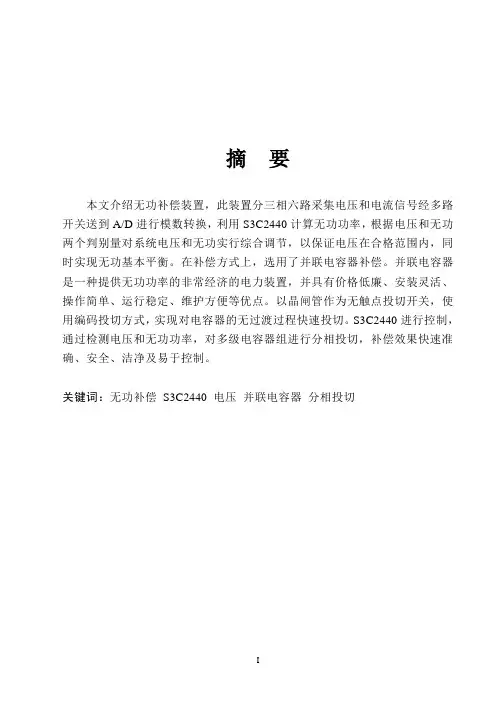无功补偿装置的设计ppt——毕业论文24页PPT
- 格式:ppt
- 大小:2.16 MB
- 文档页数:24





摘要随着社会的日益发展和科学技术的深度探索,电对人们的生活越发的重要.电压质量对电网稳定及电力设备安全运行,线路损失,用电单耗和人民生活用电都有直接影响.本文主要介绍了无功因数的基本概念及研究意义和无功补偿技术的现状以及治理的原则和目的,同时,也对静止无功功率理论做简要介绍,在本文中也对其中SVC型动态无功功率补偿装置的设计和保护做了一定说明。
我们主要从硬件设计上来更好掌握SVC技术,不管是在控制策略的选择,还是无功补偿容量确定上,都有必要把握这些细节。
在研究低压电网中无功补偿时,也对SVC系统的保护系统做了重点研究,这将是整个系统正常运行的基本前提。
关键词:无功功率;静止无功功率理论;动态补偿;SVC目录绪论 (1)一、无功补偿设计背景 (1)(一)无功功率的基本概念及研究意义 (2)(二)无功补偿技术对电力系统的影响 (2)(三)无功功率补偿方式及特点 (5)二、低压电网中无功功率补偿 (7)(一)动态无功补偿技术 (7)(二)SVC技术 (7)(三)SVC技术未来发展分析 (8)(四)低压电网中动态无功补偿装置的技术特点 (9)三、SVC动态无功补偿控制装置的设计 (11)(一)动态无功补偿器的工作原理 (11)(二)主电路及容量设计 (13)(三)控制电路及控制器选择 (14)(四)动态无功补偿控制装置的设计 (17)四、系统的保护配备 (23)(一)电网系统保护 (23)(二)电容器组保护 (23)(三)晶闸管阀保护 (25)结论 (26)参考文献 (27)致谢 (28)绪论由于现代电力电子产品的广泛应用,以及负荷的快速变化引起电压波动和闪变,使无功补偿问题变得更复杂。
电力系统中非线性负荷的与日俱增,导致大量谐波电流流入电网,造成系统电压波形严重畸变。
影响到系统用电设备的正常运行,严重时引起系统谐振,烧毁电气设备,引发电气事故,造成巨大的经济损失。
因此,对于电能质量改善装置提出了迫切的要求。



BI YE SHE JI(20 届)低压电网SVG无功补偿装置设计所在学院专业班级自动化学生姓名学号指导教师职称完成日期年月摘要近年来,由于工业的迅速发展,大功率非线性负荷的不断增加,不但改变了电力系统的电网结构,对电网的冲击和谐波污染也不断上升,造成系统无功分布不合理,甚至可能造成局部地区无功严重不足和电压水平普遍较低的情况,以致出现种种电能质量问题,如功率因数低、谐波含量高、三相不平衡、功率冲击、电压闪变和波动等等。
通过合理的方案对电网进行适当的无功补偿,能维持系统电压水平、提高系统电压稳定和设备利用率、提高功率因数避免大量无功的远距离传输、提高输电能力、平衡三相功率、提高系统运行安全性和可靠性。
此外,还可以减少网络有功损耗减少费用。
本设计运用静止无功补偿(SVG)技术对低压电网进行无功补偿,SVG采用基于瞬时无功功率理论的无功电流检测方式,采用IGBT组成的电压逆变电路模块。
主要设计包括主电路设计、控制电路设计、测量单元设计、驱动电路以及滤波电路单元等。
由于需要随时进行无功功率的检测和补偿,对控制器的速度要求较高,可以选择DSP进行控制控制单元的设计。
本论文所设计的SVG系统总体结构包括以下几个部分:主电路、控制电路、测量电路、驱动电路和电源电路等几部分。
测量电路采集负载电流信号、装置输出电流信号、系统接入点电压信号和直流侧电容电压信号等数据,然后,将这些数据信号传输给控制电路,控制电路根据给定的控制策略对从测量电路输送过来的信号数据进行处理,产生触发逆变器的驱动信号,传送到驱动电路,驱动电路将从控制电路接收到的驱动信号进行功率放大,然后加到逆变器,从而控制逆变器输出端输出无功电流的变化,实现无功动态补偿的目的。
关键词:静止无功功率发生器(SVG),无功补偿,IGBTIAbstractIn recent years, the rapid development of the industry, high power nonlinear loads increase, not only changed the power system network structure, impact on the power grid and the harmonic pollution is increasing, causing system reactive power distribution is not reasonable, even may cause local reactive power shortage and voltage level is generally low, so that there are all sorts of power quality problems, such as low power factor, harmonic content is high, three-phase unbalance, power shock, voltage flicker and wave etc.. Through the reasonable scheme of power system proper reactive power compensation, can maintain the system voltage level, improve system voltage stability and the utilization ratio of equipment, to improve the power factor and avoid a large amount of reactive power for long distance transmission, improve the transmission capacity, balanced three-phase power system, improve the safety and reliability of the operation. In addition, also can reduce the network active power loss reduction cost.The design of the use of static var generator (SVG) technology on the low-voltage reactive power compensation, SVG is based on the instantaneous reactive power theory of reactive current detection method, using IGBT consisting of voltage inverter circuit module. The main design including the main circuit design, control circuit design, measurement unit design, driving circuit and filter circuit unit. Due to the need to carry out reactive power detection and compensation, and the controller speed is higher, can select DSP control unit design.The design of SVG system structure includes the following parts: main circuit, control circuit, a measuring circuit, a drive circuit and a power supply circuit etc. Measuring circuit of load current signal acquisition device, the output current signal, system access point voltage signal and the DC side capacitor voltage signal data, and then, the data signals are transmitted to the control circuit, the control circuit according to the control strategy from the measuring circuit transmitted signal data processing, generating a trigger inverter drive signal, is transmitted to the drive circuit,IIdrive circuit from the control circuit receives the driving signal of power amplifier, and then applied to the inverter, thereby controlling the inverter output reactive current change, achieve the purpose of dynamic reactive power compensation.Key Words: static reactive power generator(SVG), reactive power compensation, IGBTIII目录摘要 (I)ABSTRACT (II)目录 ......................................................................................................................... I V 第一章绪论 .. (1)1.1课题研究的背景及意义 (1)1.2无功补偿技术的发展 (2)1.3静止无功发生器国内外发展现状 (4)1.4本设计的主要任务 (5)第二章SVG无功补偿装置设计 (6)2.1总体结构设计 (6)2.2SVG工作原理 (7)2.3主电路设计 (9)2.3.1整流电路设计 (9)2.3.2逆变电路设计 (10)2.3.3直流侧电容设计 (12)2.3.4连接电抗器设计 (12)2.4控制电路 (13)2.4.1 TMS320F2812的主要特点 (14)2.4.2片外程序和数据存储器 (15)2.4.3时钟电路 (15)2.4.4电源电路 (16)2.4.5 JTAG仿真接口电路 (17)2.4.6复位电路设计 (18)2.4.7串行通信 (19)2.5驱动电路 (19)2.6测量电路 (20)第三章控制策略及软件设计 (22)IV3.1控制策略选择 (22)3.1.1直流间接控制 (22)3.1.2直流直接控制 (24)3.2瞬时无功功率检测 (25)3.3软件流程及程序设计 (27)第四章结论 (32)4.1主要工作 (32)4.2需进一步完善的工作 (32)参考文献 (33)致谢 (35)V第一章绪论1.1 课题研究的背景及意义随着现代工业的不断进步,人们对电能质量的要求越来越高,而现在各种大功率非线性设备的应用影响电能的质量。

摘要本文介绍无功补偿装置,此装置分三相六路采集电压和电流信号经多路开关送到A/D进行模数转换,利用S3C2440计算无功功率,根据电压和无功两个判别量对系统电压和无功实行综合调节,以保证电压在合格范围内,同时实现无功基本平衡。
在补偿方式上,选用了并联电容器补偿。
并联电容器是一种提供无功功率的非常经济的电力装置,并具有价格低廉、安装灵活、操作简单、运行稳定、维护方便等优点。
以晶闸管作为无触点投切开关,使用编码投切方式,实现对电容器的无过渡过程快速投切。
S3C2440进行控制,通过检测电压和无功功率,对多级电容器组进行分相投切,补偿效果快速准确、安全、洁净及易于控制。
关键词:无功补偿S3C2440 电压并联电容器分相投切AbstractThis paper introduces the reactive power compensation device, this device is divided three six road collecting voltage and current signals by a multichannel selective switch to A/D conversion. S3C2440calculation of reactive power, according to the voltage and reactive power two discriminant volume on system voltage and reactive power comprehensive regulation, in order to ensure the qualified voltage, while realizing reactive power equilibrium. On compensation way, selection of the parallel capacitor compensation, shunt capacitor is a reactive power economic power device, shunt capacitor with low price, flexible installation, simple operation, stable running, convenient maintenance and so on. And to the thyristor as a non-contact switch, use of code switching mode, realize the capacitor without the transition process of fast switching. Using S3C2440control, by detecting the voltage and reactive power, the multistage capacitor group split-phase switching, compensation effect quickly and accurately, safe, clean and easy to control.Key words: reactive power compensation S3C2440 voltage shunt capacitor phase switching目录摘要 (I)Abstract (II)第1章绪论 (1)1.1 无功补偿的目的和意义 (1)1.2 国内外发展状况 (2)1.2.1 无功补偿方式的发展现状 (2)1.2.2 无功补偿技术的发展趋势 (5)1.3 本文研究的主要内容 (5)第2章无功补偿的原理及调节判据 (7)2.1 无功补偿原理 (7)2.1.1 无功补偿的主要作用 (8)2.1.2 无功补偿电容器的容量的选择 (10)2.2 并联电容器补偿 (10)2.3 并联补偿电容器的配置原则 (12)2.4 调节判据的选择 (13)2.5 电容器组的投切对系统电压和无功的影响 (14)第3章主系统设计 (17)3.1 工作过程 (17)3.2 电容器投切接线方式选择 (19)3.3 电容器组投切方式 (20)3.4 晶闸管电压过零触发电路 (23)3.5 器件的选型 (25)3.5.1 晶闸管的选型 (25)3.5.2 电抗器的选型 (26)第4章硬件电路设计 (29)4.1 主控制器 (29)4.2 电源电路设计 (31)4.3 电压电流检测电路设计 (33)4.4 功率因数角检测电路设计 (35)4.5 按键电路设计 (38)4.6 显示电路设计 (39)4.7 投切控制电路设计 (40)第5章软件设计 (42)5.1 电网参数采集模块 (43)5.2 按键模块部分 (44)5.3 显示模块 (44)5.4 投切控制模块 (45)经济与社会效益分析 (47)结论 (48)致谢 (49)参考文献 (50)附录 (53)CONTENTSAbstract (Chinese) (I)Abstract (English) (II)The first chapter Introduction (1)1.1 The purpose and significance of reactive power compensation11.2 The domestic and foreign development condition (2)1.2.1 The current situation of the development of reactivepower compensation (2)1.2.2 Reactive power compensation technology developmenttrend (5)1.3 The main contents of this paper (5)The second chapter The principle of reactive compensation and control criteria (7)2.1 Reactive compensation principle (7)2.1.1 The main role of reactive power compensation (8)2.1.2 Reactive compensation capacitor capacity selection (10)2.2 Parallel capacitor compensation (10)2.3 Shunt compensation capacitor allocation principle (12)2.4 The choice of regulation criterion (13)2.5 Capacitor on system voltage and reactive power impact (14)The third chapter The main system design (17)3.1 Working process (17)3.2 Capacitor wiring mode selection (19)3.3 Capacitor bank switching mode (20)3.4 Thyristor voltage cross zero trigger circuit (23)3.5 Device selection (25)3.5.1 Thyristor type selection (25)3.5.2 Reactor type selection (26)The fourth chapter Hardware circuit design (29)4.1 Master controller (29)4.2 Power circuit design (31)4.3 Voltage and current detecting circuit design (33)4.4 Power factor angle detection circuit design (35)4.5 Key circuit design (38)4.6 Design of display circuit (39)4.7 Switching control circuit design (40)The fifth chapter Software design (42)5.1 Power grid parameter acquisition module (43)5.2 Key module (44)5.3 Display module (44)5.4 Switching control module (45)Economic and social benefit analysis (47)Conclusion (48)Thank (49)Reference (50)Appendix (53)第1章绪论1.1无功补偿的目的和意义随着国民经济持续快速增长,工业企业的数量不断增加,人们生活水平不断提高,使用电量的需求大大增加。